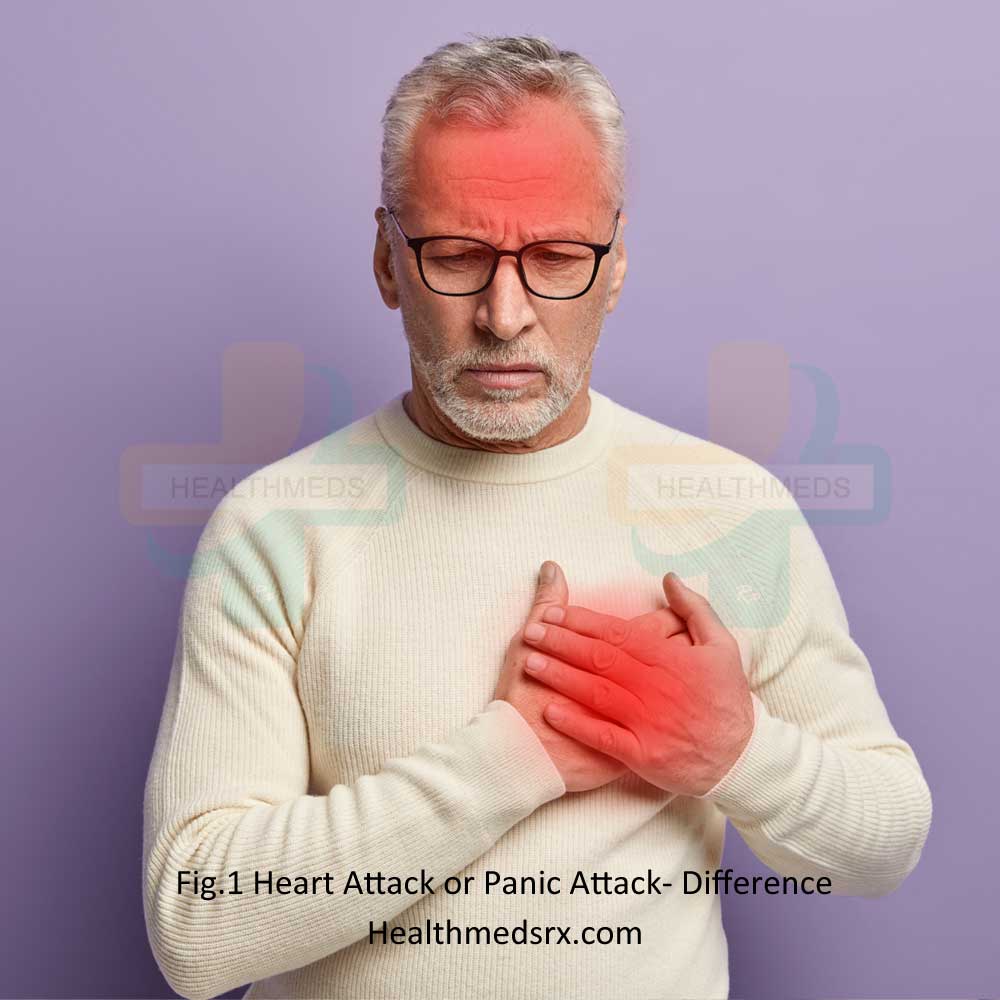Heart Attack or Panic Attack- Difference

A heart attack, medically known as a myocardial infarction, occurs when there is a sudden blockage of blood flow to the heart muscle. It usually happens due to the formation of a blood clot in one of the coronary arteries, which supply oxygen-rich blood to the heart. The blockage deprives the heart muscle of oxygen, leading to damage or death of the affected tissue. Common symptoms of a heart attack include chest pain or discomfort, shortness of breath, nausea, light-headedness, and pain radiating to the arm, jaw, or back. Prompt medical attention is crucial to minimize heart damage and improve survival rates. Treatment options may involve medications to dissolve the clot, angioplasty to open the blocked artery, or bypass surgery to restore blood flow.
On the other hand, a panic attack is an intense episode of overwhelming fear or anxiety that arises abruptly and reaches its peak within minutes. It is a manifestation of a panic disorder, a type of anxiety disorder. Panic attacks can be triggered by specific situations or can occur unexpectedly without any apparent cause. Symptoms of a panic attack often mimic those of a heart attack, such as chest pain, rapid heartbeat, shortness of breath, dizziness, trembling, sweating, and a sense of impending doom. However, panic attacks do not cause any physical damage to the heart. Treatment for panic attacks may involve therapy, such as cognitive-behavioral therapy (CBT), and medications like anti-anxiety drugs or antidepressants.
In summary, while a heart attack is a life-threatening condition caused by a blockage in the coronary arteries, leading to damage to the heart muscle, a panic attack is a sudden and intense episode of anxiety or fear that does not pose a direct physical threat but can be highly distressing for the individual experiencing it.
Common Symptoms of Heart Attacks vs. Panic Attacks
Heart attacks and panic attacks can share similar symptoms, making it difficult to distinguish between the two. Common symptoms of heart attacks include chest pain or discomfort, shortness of breath, pain radiating to the arm, jaw, or back, nausea, sweating, and lightheadedness. On the other hand, panic attacks may manifest as chest pain, rapid heartbeat, shortness of breath, dizziness, trembling, sweating, and a sense of impending doom. While heart attacks are typically caused by a blocked artery, panic attacks are often triggered by intense anxiety or stress. It is crucial to seek medical attention immediately when experiencing these symptoms to ensure proper diagnosis and treatment.
How to Differentiate Between Heart Attacks & Panic Attacks?
Differentiating between heart attacks and panic attacks can be crucial in order to seek appropriate medical attention. Although both conditions can present with similar symptoms, there are a few key differences. Heart attacks typically involve severe chest pain or discomfort that may radiate to the left arm or jaw, accompanied by shortness of breath, nausea, and sweating. On the other hand, panic attacks often manifest as sudden episodes of intense fear or anxiety, accompanied by rapid heartbeat, trembling, shortness of breath, and a sense of impending doom. Consulting a healthcare professional is vital for an accurate diagnosis and proper treatment based on individual symptoms and medical history.
Tips for Preventing Heart Attacks & Panic Attacks
Preventing Heart Attacks:
1. Maintain a healthy lifestyle: Adopting a balanced diet rich in fruits, vegetables, whole grains, and lean proteins, while limiting processed foods, saturated fats, and sodium, can help prevent heart attacks. Regular exercise, such as aerobic activities and strength training, is also crucial.
2. Quit smoking: Smoking damages blood vessels, reduces the oxygen supply to the heart, and increases the risk of heart attacks. Quitting smoking significantly improves heart health.
3. Manage stress: Chronic stress contributes to heart disease. Take part in stress-reducing activities like yoga, meditation, deep breathing, or enjoyable hobbies. Set time aside for relaxation and self-care.
4. Control blood pressure and cholesterol: High blood pressure and cholesterol levels increase the risk of heart attacks. Monitor these levels regularly and work with your healthcare provider to manage them through medication, diet, and lifestyle changes.
Preventing Panic Attacks:
1. Practice relaxation techniques: Deep breathing exercises, progressive muscle relaxation, and mindfulness meditation can help reduce anxiety and prevent panic attacks. Regularly incorporate these techniques into your daily routine.
2. Identify triggers: Pay attention to situations, thoughts, or emotions that tend to trigger panic attacks. Once you identify them, develop strategies to cope with or avoid these triggers whenever possible.
3. Exercise regularly: Physical activity releases endorphins, which can improve your mood and reduce anxiety. On most days of the week, try to get in at least 30 minutes of moderate activity.
4. Seek support: Share your concerns with trusted friends, family, or a therapist. Talking about your feelings can provide relief and help you gain perspective on your anxiety.
5. Limit caffeine and alcohol: Both caffeine and alcohol can increase anxiety and trigger panic attacks in susceptible individuals. Limit or avoid their consumption, especially during periods of increased stress.
Remember, these tips can contribute to overall heart and mental health, but it’s important to consult with healthcare professionals for personalized advice and guidance.
Additionally, you might strive to exert emotional self-control. If you are able to stop the attack and the symptoms disappear, you are unquestionably experiencing a panic attack. However, if you have even the slightest uncertainty, you should seek medical attention.The procedures required to ascertain what kind of attack you are having can be done by a doctor. He will be able to provide the required treatment based on the findings of the tests.

